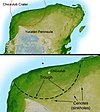User:Abyssal/Portal:Sauropterygians/Sauropterygian articles/2
Chicxulub Crater is an ancient impact crater buried underneath the Yucatán Peninsula, with its center located near the town of Chicxulub, Yucatán, Mexico. The crater is over 180 kilometers (110 mi) in diameter, making the feature one of the largest confirmed impact structures in the world; the asteroid or comet whose impact formed the crater was at least 10 km (6 mi) in diameter. The crater was named for the nearby town, as well as for the literal Maya translation of the name: "tail of the devil."
The crater was discovered by Glen Penfield, a geophysicist who had been working in the Yucatán while looking for oil during the late 1970s. The presence of tektites, shocked quartz and gravity anomalies, as well as the age of the rocks and isotope analysis, show that this impact structure dates from the late Cretaceous Period, roughly 65 million years ago. The impact associated with the crater is implicated in causing the extinction of the dinosaurs as suggested by the Cretaceous–Paleogene boundary, although some critics disagree that the impact was the sole reason and also debate whether there was a single impact or whether the Chicxulub impactor was one of several that may have struck the Earth at around the same time. Recent evidence suggests that the impactor was a piece of a much larger asteroid which broke up in a collision more than 160 million years ago.(see more...)

